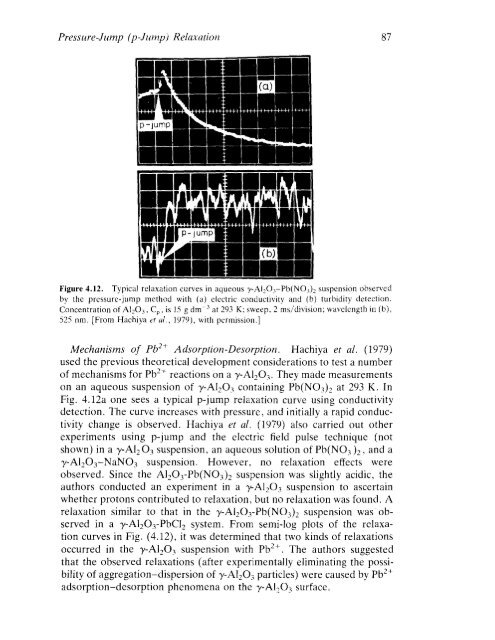p18ctqouf5gk614re1k6k1lc31s0l4.pdf
You also want an ePaper? Increase the reach of your titles
YUMPU automatically turns print PDFs into web optimized ePapers that Google loves.
Pressure-Jump (p-Jump) Relaxation 87<br />
Figure 4.12. Typical relaxation curves in aqueous y-AI 2 0,-Pb(N0 3 )2 suspension observed<br />
by the pressure-jump method with (aJ electric conductivity and (b) turbidity detection.<br />
Concentration of A1 2 0 3 , C p<br />
, is 15 g dm- 3 at 293 K; sweep, 2 ms/division; wavelength in (b),<br />
525 nm. [From Hachiya et al., 1979), with permission.]<br />
Mechanisms of Pb 2 + Adsorption-Desorption. Hachiya et al. (1979)<br />
used the previous theoretical development considerations to test a number<br />
of mechanisms for Pb 2 + reactions on a y-AI 2 0 3 . They made measurements<br />
on an aqueous suspension of y-A1 2 0 3 containing Pb(N0 3 h at 293 K. In<br />
Fig. 4.12a one sees a typical p-jump relaxation curve using conductivity<br />
detection. The curve increases with pressure, and initially a rapid conductivity<br />
change is observed. Hachiya et al. (1979) also carried out other<br />
experiments using p-jump and the electric field pulse technique (not<br />
shown) in a y-A1 2 0 3 suspension, an aqueous solution of Pb(N03 h, and a<br />
y-AI 2 0 r NaN0 3 suspension. However, no relaxation effects were<br />
observed. Since the AI 2 0 3 -Pb(N0 3 h suspension was slightly acidic, the<br />
authors conducted an experiment in a y-A1 2 0 3 suspension to ascertain<br />
whether protons contributed to relaxation, but no relaxation was found. A<br />
relaxation similar to that in the y-Ah03-Pb(N03h suspension was observed<br />
in a y-AI 2 0 3 -PbCI 2 system. From semi-log plots of the relaxation<br />
curves in Fig. (4.12), it was determined that two kinds of relaxations<br />
occurred in the y-AI 2 0} suspension with Pb 2 +. The authors suggested<br />
that the observed relaxations (after experimentally eliminating the possibility<br />
of aggregation-dispersion of y-A1 2 0 3 particles) were caused by Pb 2 +<br />
adsorption-desorption phenomena on the y-A1 2 0 3 surface.


